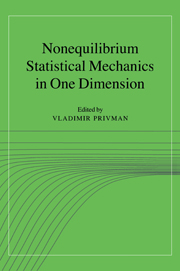Book contents
- Frontmatter
- Contents
- Contributors
- Preface
- Part I Reaction-Diffusion Systems and Models of Catalysis
- 1 Scaling theories of diffusion-controlled and ballistically controlled bimolecular reactions
- 2 The coalescence process, A + A → A, and the method of interparticle distribution functions
- 3 Critical phenomena at absorbing states
- Part II Kinetic Ising Models
- Part III Ordering, Coagulation, Phase Separation
- Part IV Random Adsorption and Relaxation Processes
- Part V Fluctuations in Particle and Surface Systems
- Part VI Diffusion and Transport in One Dimension
- Part VII Experimental Results
- Index
- Abbreviations
3 - Critical phenomena at absorbing states
Published online by Cambridge University Press: 18 December 2009
- Frontmatter
- Contents
- Contributors
- Preface
- Part I Reaction-Diffusion Systems and Models of Catalysis
- 1 Scaling theories of diffusion-controlled and ballistically controlled bimolecular reactions
- 2 The coalescence process, A + A → A, and the method of interparticle distribution functions
- 3 Critical phenomena at absorbing states
- Part II Kinetic Ising Models
- Part III Ordering, Coagulation, Phase Separation
- Part IV Random Adsorption and Relaxation Processes
- Part V Fluctuations in Particle and Surface Systems
- Part VI Diffusion and Transport in One Dimension
- Part VII Experimental Results
- Index
- Abbreviations
Summary
Continuous phase transitions from an absorbing to an active state arise in diverse areas of physics, chemistry and biology. This chapter reviews the current understanding of phase diagrams and scaling behavior at such transitions, and recent developments bearing on universality.
Introduction
Stochastic processes often possess one or more absorbing states—configurations with arrested dynamics, admitting no escape. Phase transitions between an absorbing state and an active regime have been of interest in physics since the late 1950s, when Broadbent and Hammersley introduced directed percolation (DP). Subsequent incarnations include Reggeon field theory, a high-energy model of peripheral interest to most condensed matter physicists, and a host of more familiar problems such as autocatalytic chemical reactions, epidemics, and transport in disordered media. For the simpler examples—Schlögl's models, the contact process, and directed percolation itself—many aspects of critical behavior are well in hand. In the mid-1980s absorbing-state transitions found renewed interest due to the catalysis models devised by Ziff and others, and to a proposed connection with the transition to turbulence. A further impetus has been the ongoing quest to characterize universality classes for these transitions. Parallel to these developments, probabilists studying interacting particle systems have established a number of fundamental theorems for models with absorbing states.
Interest in the influence of kinetic rules on the phase diagram has spawned many models over the last decade; the majority must go unmentioned here.
- Type
- Chapter
- Information
- Nonequilibrium Statistical Mechanics in One Dimension , pp. 51 - 70Publisher: Cambridge University PressPrint publication year: 1997
- 2
- Cited by



